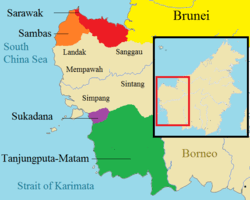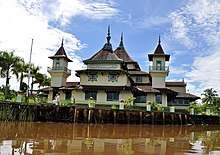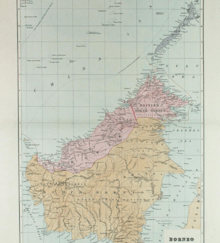Sultanate of Sarawak
There are two versions of the early kingdoms in modern Sarawak which cover the northwest of Borneo Island. The first version states that there was an old Santubong kingdom at Bukit Maras, which was originated from the neighbouring Tanjungpura kingdom. After the Santubong kingdom ended, there were some more subsequent kingdoms established to continue its legacy i.e. Iban, Malano, Samarahan, Sadong, Kalaka and Saribas. The second version says that Pangeran Mudah Tengah of Brunei established a kingdom at Bukit Bedil near the foot of the Santubong mountain.
| 1599–1641 | |||||||||||
 Flag | |||||||||||
 The polity of western Borneo, 17th century, with Sarawak in Red. The kingdoms that established close relationship with Sarawak are illustrated in colour, while other neighbouring kingdoms are represented in light brown. | |||||||||||
| Capital | Santubong | ||||||||||
| Common languages | Classical Malay | ||||||||||
| Religion | Islam, local animism | ||||||||||
| Government | Monarchy | ||||||||||
| Sultan | |||||||||||
• 1599–1641 | Sultan Ibrahim Ali Omar Shah | ||||||||||
| History | |||||||||||
• The foundation of Sarawak | 1599 | ||||||||||
• Assassination of Sultan Tengah | 1641 | ||||||||||
| Currency | Barter | ||||||||||
| |||||||||||
| Today part of | |||||||||||

Santubong kingdom, Tanjungpura-originated
The Santubong kingdom started since circa 500 AD.[1] It was under Srivijaya and Majapahit. James Brooke found "Nandi dan Yoni" in 1857 and later gold artifacts. Sarawak Museum under Tom Harrisson in 1949 collected thousands of ceramic pieces at Santubong which indicates Santubong existed as a settlement between 7th until 10th or 14th centuries. Iron-slag about 40,000 tonnes was found at Santubong which shows it was a major and vital fort-city. The iron industry existed between 900s to 1350s. Even O.W. Wolters confirms China has known this iron slag since the 13th century and interpreted that Pulau Tan-lan mentioned in the Chinese report as located in the western of Sarawak which locally known as Pulau Talang-Talang. However, archaeologists or Sarawak Museum never associates Pulau Talang-Talang with the discovery of the iron slag although its distance is not far from Santubong.
At Bongkissam, thousands of ceramic pieces were found and dated to exist up to the 14th century by Sarawak Muzeum. The Chinese manuscript of Nan-hai-chih listed the kingdoms in Borneo in 1304. Brunei was written by China as Tung-yang Fo which indicates it controls the entire north Borneo. The Negarakartagama manuscript of Java written in 1365 shows that Bo-ni (Barune) was under Majapahit whose expansion up to 1350 diverted trade with China from Santubong to perhaps Bo'ni or elsewhere, therefore no ceramics from the Ming dynasty are found at Santubong. Santubong's name was lost from history and a new name, Sawaku (Sarawak) in Negarakartagama. The presence of Majapahit perhaps caused the local population to migrate to uplands like Samarahan and Sadong.
The first version of the origin of Santubong is according to the narration and genealogy provided by the present descendent of the "Tungkat Kerabat" of the Santubong kingdom.[2] The kingdom started at Santubong and expanded to cover the whole northwest of Borneo.
It was established by Indrana Jang Sorgi (Hyang Gi) who became the first ruler of the area. He was from Tanjong Pura. His grandfather's name was Indrana Manika, the first ruler of Tanjong Pura. When Indrana Manika died, he was replaced by his son Indrana Sapan who became the second ruler of Tanjong Pura. Indrana Sapan had two sons, Indrana Jang Talar and Indrana Jang Sorgi. Talar was also known as Hyang Ta while Sorgi as Hyang Gi. The message from the grandfather, Indrana Manika, stated he wanted one of his grandsons to rule Tanjong Pura after their father's death.
In intrigue before the appointment of Hyang Gi, Indrana Jang Talar (Hyang Ta) was made the ruler of Tanjong Pura. This made Indrana Jang Sorgi (Hyang Gi) unhappy with the decision. He requested that Talar give the throne to him after Talar ruled Tanjong Pura for ~ ten years. To avoid a dispute among those within the palace, Talar gave Indra Jang Sorgi (Hyang Gi) the area of Mora Ponek (Santubong) to rule. Hyang Gi agreed with the arrangement. He built his kingdom at Mora Ponek. He changed the name, Mora Ponek to Indra Ponek (Muara Tebas now). The rest is history as they say.
The list of rulers of the Santubong kingdom is as follows:
- i. Indrana Manika (grandfather's name, the first king of the Tanjungpura kingdom)
- ii. Indrana Sapan (the second ruler of Tanjong Pura kingdom)
- iii. Indrana Jang Talar aka Hyang Ta
- 1. Indrana Jang Sorgi aka Hyang Gi, ~925-974
- 2. Indra Siak, 974-1011
- 3. Sagenta Galam (Indra Galam real name), 1011-1053
- 4. Saganda Sarik (Indra Sarik real name), 1053-1096
- 5. Saganda Leleng (Indra Ragga), 1096-1131
- 6. Saganda Surik (Indhara Uteh), 1131-1173
- 7. Saganda Pratima (Indra Simma), 1173-1211
- 8. Saganda Siga (Indraka Sigat), 1211-1242
- 9. Saganda Junjunan (Indrana Junjunan), 1242-1277
- 10. Saganda Manikam (Siagasangsana), 1277- 1303
- 11. Pangiran Tuanku Mahkuta (Indra Lewang), 1303-1332
- 12. Indra Daha (Raja Leok /Raja Elok), 1332-1376
- 13. Indranajakkiana or Pangiran Tuanku Mahraja Kanna, 1376-1408
- 14. Indrana Rajian aka Tuanku Ibrahim Jaffaruddin aka Sultan Abdul Jalil Ibrahim Jaffaruddin, The First Raja Tengah, 1408 - 1447
- 15. Ismail Hasanuddin aka Sultan Abdul Jalil Ismail Hasanuddin, The Second Sultan Tengah (Indrana Ngemas), 1462 - 1490
- 16. Sultan Abdul Jalil Muhammad Al Hafiz Zussalam, the third and last Sultan of Santubong, 1490 - 1512 (The last sultan who used the title Abdul Jalil after his late brother and father)
- 17. Tuanku Ibrahim bin Abdullah Muhammad (vanished)
- 18. Pangiran Paduka Tuan Muhammad Daud - acting Sultan
- 19. Moheddin bin Tuanku Ibrahim (hiding)
According to this Tungkat Kerabat, the Brunei kingdom attempted to colonize Sarawak at least four times. The first time was when Awang Balitar assassinated Abdullah Muhammad in 1512 and exterminated himself. The Brunei troop attacked and conquered Santubong on 15 August 1512, following the fall of Malacca to Portuguese in 1511. The second time was when Pangeran Muda Tengah from 1599-1641 aka Sultan Ibrahim Ali Omar Shah established a fort at Bukit Bedil at the foot of Mount Santubong in 1599. The third time was when Pengiran Kasuma Yuda Pengiran Sharifuddin (died 1832) migrated to Sadong. He was the father of Pengiran Indera Mahkota Muhamad Salleh who became the Sultan Brunei's representative to the Sarawak proper (now Kuching) in 1826 and relocated his court to a place called Serwak to try and control the antimony trade in favour of the Brunei Sultan. There is a mausoleum of Pengiran Anak Sabtu at Muara Tuang to this day. The fourth time was in 1834 when Raja Muda Hashim arrived at Sarawak with his 13 brothers (Walker 2002 p.26). They established a settlement at the present Astana. James Brooke arrived at Sarawak from Singapore in 1838 and became the first White Rajah of Sarawak in 1841.
Iban kingdom
It existed between circa 700 to 1300 AD in the middle of the northwestern Borneo Island, from The Rajang river to the Baram river.[3]
Malano kingdom
The Melano kingdom existed circa 1300 to 1400 AD [4], headed by Raja Tugau, succeeding the preceding Iban kingdom. Raja Tugau expanded his kingdom from Igan northwards and conquered Tutong near Barunai. His kingdom is known as Likao (literally meaning tattooed) by Barunai. Barunai conquered Tutong and the whole of the Melano kingdom until Igan. Nagarakertagama written in 1365 during Hayam Wuruk mentions Melano and Barune among its tributaries. Catalan Atlas published in 1375 shows the map of the Malano kingdom in it. This was confirmed by a Portugues map which shows the existence of a polity called Malao. At Florence, Italy an old map dated 1595 wrote that the Sarawak coastal areas as districts of Oya, Balingian dan Mukah which was marked as Malano. In the Nan-hai-chih of China mentioned Achen atau Igan.
Samarahan kingdom
It was started c1300 AD, at Mawang Taup with a discovery of a stone statue believed to belong Datu Merpati Jepang.
Sadong Kingdom
There are three discoveries of Chinese ceramic pieces dated between 13 to 14th centuries that show the existence of the Sadong kingdom, which is possibly a continuance of the Santubong kingdom. First, at Gedong (40 miles from Santubong) where 79,754 ceramic pieces and hundreds of artifacts like beads, shillings and gold. Second, at Bukit Sandong where 30,000 of ceramic pieces were found and their origin and age are like those found at Santubong and Gedong. Third, gold pieces were found by public at Gumpey, near Simunjan in 2008 which is evidence that Samarahan kingdom existed before.
Kalaka Kingdom
Negarakartagama written in 1365 states that "Kalka” is one of the kingdoms under Majapahit. At the Kalaka rivermouth valley, 9,469 Chinese ceramic pieces were found, including the types of Sawankhalok dan “blue and white ware”. These were dated by Lucas Chin to be ceramics of 16 to 17th centuries. Also, at Tebing Tinggi were 41,762 ceramic pieces that are of the same age and type with those found at Nanga Kalaka.
Saribas Kingdom
The Saribas kingdom existed in circa 1300 AD based on Salsilah Raja-Raja Melayu. An old manuscript (Syair Saribas) mentions that the Saribas kingdom existed in the 17th century with its capital at Tandang Sari, now called Pusa.
Sarawak kingdom, Brunei-instituted
in this second version, The Sultanate of Sarawak (Malay: Kesultanan Sarawak; Jawi:كسلطانن سراوق دارول هان) was a traditional Malay kingdom, precursor of the present-day Kuching Division, Sarawak. The kingdom was founded in 1599 and witnessed the reign of a sole Sultan, Sultan Tengah, Prince of Brunei, known as Ibrahim Ali Omar Shah of Sarawak.[5] The state established close relationship with Brunei, Johor and forged dynastic rules to the surrounding Malay kingdoms in western Borneo including Sambas, Sukadana and Tanjungpura-Matan.[6] The kingdom was dissolved following Sultan Tengah's assassination in 1641. The administration of the territory was then replaced by the local Malay governors appointed from Brunei, reunifying the area into Brunei prior to the White Rajah era.
According to the Salahsilah Raja-Raja Brunei (Bruneian Royal Annals), the state was established following the demise of Sultan Muhammad Hassan, the monarch of Bruneian Empire who ruled between 1582 and 1598. The death of the sultan witnessed the enthronement of Abdul Jalilul Akbar, the eldest prince of Muhammad Hassan as the Sultan of Brunei. However, the crowning of Abdul Jalil Akbar was objected by Pengiran Muda Tengah, claiming that the status of Abdul Jalilul was invalid as the elder prince was born before their father become the Sultan, in contrast to the Pengiran who was born after his father's ascension to the throne, hence he believed that he had the superior right to inherit the kingdom.[7]
Already anticipating this dispute, the newly crowned Sultan of Brunei appointed the Pengiran Muda Tengah as the Sultan of Sarawak, a frontier territory far from the central core of the Bruneian kingdom. The departure of the Pengiran was accompanied by more than 1000 soldiers from the Sakai, Kedayan, and Bunut tribes, natives of Borneo. A coterie of Bruneian nobility also followed him to develop the administration system in the new kingdom.[8] Today, a number of Kuching and Sambas Malay community can trace their origin from the pioneers.[9]
The new Sultan constructed a fortified palace in Sungai Bedil, Santubong, morphing the area into the royal, judicial and administrate capital of the kingdom. He began appoint his deputies and delegates, incorporating the position of Datu Seri Setia, Datu Shahbandar Indera Wangsa, Datu Amar Setia Diraja and Datuk Temenggong Laila Wangsa in the governance system. He proclaimed as the sultan after completing the administration system of the new kingdom, bearing the regal name of Sultan Ibrahim Ali Omar Shah. According to Sambas Royal records, Sultan Tengah Manga was known as Sultan Abdul Jalil.[10]
Sarawak–Johor diplomatic crisis
Sometime in the early 17th century, Sultan Tengah was on a trip to Pahang, (then an autonomous-kingdom in Johor) to visit his aunt The Raja Bonda or, Queen Creek of Pahang. Before he left, he elected four Datuks (nobleman) to administer his kingdom. His aunt was married to the sultan, Abdul Ghafur Muhiuddin Shah. While in Johor, he was invited to perform in a courtly dance. It was during the performance that one of the dancers almost hit the face of Sultan Tengah with a handkerchief by accident. The furious Sultan Tengah then slapped the dancer. This caused a disappointment in the Sultan of Pahang who then ordered the Sarawakian Royal entourage to immediately leave his kingdom.[9]
However, based on the narration of Sultanate of Sambas, Sultan Tengah was ordered to leave Johorean soil because of his refusal to marry Princess Cik Zohra upon the request of his aunt, The Queen Consort of Pahang.
Sarawak–Sukadana alliance
The royal entourage was hit by a major storm during their return voyage to Borneo. The vessel was then blew off course and arrived to the shores of the Sukadana Kingdom.[10] The polity of Sukanada was ruled by a Javanese Hindu King, Penambahan Giri Mustika, he was later known as Sultan Muhammad Saifuddin after his conversion to Islam by Sheikh Shamsuddin, a missionary from Mecca. It was also during his time in Sukadana that Sultan Tengah commenced his religious studies under the guidance of Sheikh Shamsuddin.[9][11]
The Sultan later wedded Princess Puteri Surya Kesuma, sister of the reigning monarch. He also briefly settled in Sukadana and requested permission to carry out missionary activities to the local populace. His request was permitted and granted the land around the Sambas river to perform his duties. By 1600, he departed Sukadana to Sambas together with an entourage of 40 vessels with armed men.
The royal entourage arrived and built a settlement around Kuala Bangun, near the Sambas river. It was during the time in Sambas that the Puteri gave birth to a prince, Radin Sulaiman. She later gave birth to following two children's, Pengiran Badaruddin (later become Pengiran Bendahara Seri Maharaja) and Pengiran Abdul Wahab (Pengiran Temenggong Jaya Kesuma).
Sarawak–Sambas union

Located further up of the Sambas River, The sultan's arrival in Kota Lama was greatly celebrated by the Ratu Sapundak, the King of Kota Lama who welcomed the Sultan as the royal guest of honour. The King allowed Sultan Tengah to perform his missionary activities to the local populace, despite himself being a Hindu ruler of Majapahit descent. The long stay in Sambas also witnessed the marriage of his Sultan Tengah's prince, Radin Sulaiman to Puteri Mas Ayu Bongsu, the princess of Ratu Sapundak. The royal pair had a son named Radin Bima, who would later become the 2nd Sultan of Sambas.[9][11]
Following the death of Ratu Sapundak, the throne of Sambas was succeeded by Pengiran Prabu Kenchana who appointed Radin Sulaiman as one of his advisers. Historical records narrated that Ratu Sapundak had desired to appoint Sultan Tengah as his successor due to his expertise in governance and administration, although his request was highly objected by the members of Sambas aristocrats due to their religious differences, with the members of the then-Sambas nobility was predominantly of Hindu faith. However, this would change in 1631, when Radin Sulaiman rise to the crown of Sambas, bearing the regal name of Sri Paduka al-Sultan Tuanku Muhammad Safiuddin I, the first Muslim ruler of the Sambas Kingdom.[10]
Sarawak–Matan
By 1630, the sultan departed to Matan. In Matan, he married a local princess. The marriage issued a prince, Pengiran Mangku Negara, who later become the Sultan of Matan. It was after a few years in Matan that he decided to return to Sarawak.[9]
Return and death
After staying a few years in Matan, the sultan decided to return to Sarawak. In 1641, he and his party settled in Batu Buaya, Santubong while en route to Sarawak.[12] It was during his time in Batu Buaya that he was assassinated by one of his escorts.[7][13] When the news of the death of the sultan arrived in Sarawak, Datu Patinggi, Shahbandar Datu, Datu Amar and Datu Temenggong departed to Santubong to complete the funeral rites of the sultan based on the Bruneian Royal customs. The Queen consort, Ratu Surya Kesuma decided to return to the Kingdom of Sukananda after his demise.[13]
The kingdom was then reunified with Brunei following the death of the popular sultan, marking the end of an era. The local Sarawakian administration was then succeeded to the local governors appointed by the Bruneian monarch.
Legacy
The final resting place of the first and the final sultan of Sarawak was discovered in 1993, located in Kampong Batu Buaya.[14][15] A royal mausoleum was constructed in May 1995 following the rediscovery of the tomb.[11] The monument was visited by Hassanal Bolkiah, the Sultan of Brunei during his state visit to Sarawak in 2007.
The death of the sultan witnessed the demise of the Sultanate of Sarawak. Nonetheless, his reign was instrumental to the sociopolitical framework of western shores of Borneo.[16] He established his capital in Sungai Bedil which then prospered into Kuching during the White Rajah era. He also had incorporated the position of Datu Patinggi, Shahbandar Datu, Datu Amar and Datu Temenggong in the Sarawak administration system that can be seen today. While his missionary activities also transformed the native Hindu society into a Malay Muslim community in coastal Borneo, while his political marriage and alliances established new dynastic houses to the kingdoms of Sambas and Matan.[6]
References
- https://www.youtube.com/watch?v=SMeaLsDOT6I&t=210s
- https://www.academia.edu/37314768/History_of_the_people_from_the_Sarawak_River_Valley
- https://www.youtube.com/watch?v=SMeaLsDOT6I&t=210s
- https://www.youtube.com/watch?v=SMeaLsDOT6I&t=210s
- Porritt 2012
- Bruneidesi 2017
- Danielle Sendou Ringgit 2016
- Sarawak State Secretary Office 2016
- Gregory 2015
- Kaffah 2017
- Larsen 2012
- Tunku Hilda 2015
- Tomi 2014
- Arkib Negara Malaysia 2016
- Sygic 2017
- Utusan Borneo Online 2016
Bibliography
- Arkib Negara Malaysia (2016), Penemuan Makan Sultan Sarawak Pertama, Pekhabar
- Bruneidesi (2017), Sultans of Brunei
- Danielle Sendou Ringgit (2016), A brush with royalty in Sambas, The Borneo Post
- Gregory, Zayn (2015), The Maqam of Sultan Tengah, BinGreogory
- Kaffah (2017), Istana Alwatzikhubillah, Kabupaten Sambas, Kalimantan barat
- Larsen, Ib (2012), The First Sultan of Sarawak and His Links to Brunei and the Sambas Dynasty, 1599-1826: A Little known Pre-Brooke History, Malaysian Branch of Royal Asiatic Society, CiteSeerX 10.1.1.692.3022
- Porritt, Vernon L. (2012), Sarawak Proper: trading and trading patterns from earlier times to the registration of the Borneo Company in 1856., Borneo Research Council, Inc
- Sarawak State Secretary Office (2016), Sarawak Before 1841, Official Website of Sarawak State Government
- Sygic (2017), Tomb of Sultan Tengah
- Tomi (2014), Pasak Negeri Kapuas 1616-1822, Feliz Books, ISBN 978-602-961-357-5
- Tunku Hilda (2015), Kino Santubung Megalithic Mystery, KINO (Kuching In and Out)
- Utusan Borneo Online (2016), Teater Kesultanan Sarawak

